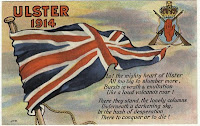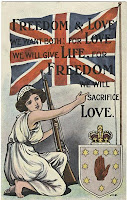These passages were published as part of the wonderful The neighbourhood of Dublin: its topography, antiquities and historical associations by Weston St. John Joyce originally published in 1912 but this updated edition was published in 1921. You can download the whole book in .pdf here, beware though it's a big file. The book describes many areas of Dublin at the time and their histories. I've no doubt I'll dip into it again for posts. The reason I picked the Swords section is because it's my hometown and current place of residence and I have some nice roughly contemporary photos of the town to complement Joyce's written passages
Passing through Drumcondra, Santry, and Cloghran, we enter the ancient town of Swords, consisting of a long, wide street, situated on the great northern road, at a distance of eight miles from the metropolis. It derives its name from the Celtic word,
sord, meaning pure, originally applied to St. Columbkille's well, which from time immerorial has been one of the principal sources of water supply in the town.
This well is on the by-road to the left as we enter the village, but is now concealed from view, a pump having been erected over it during the past few years to preserve it from contamination.
One of the most notable events in the history of Swords is the funeral of King Brian Boru and his son Morrough, after the Battle of Clontarf, when the bodies of these warriors were conveyed in solemn procession from Dublin, and deposited for the night in the ancient monastery here, on the way to their final destination in Armagh.
According to the ancient records, Swords was burnt by the Danes in 1012, 1016, 1130, 1138, 1150, and 1166AD; and in 1185 it was taken and sacked by O'Melaghlin, King Of Meath. It must, consequently, have been a much more lively place of residence in those days than at the present time.
In 1578 a Royal mandate was issued for the better establishment of the Corporation of Swords, and for the purpose of determining the limits of its franchises and liberties. Commissioners were thereupon appointed to fix the boundaries, two miles on every side from the town.
At the commencement of the Insurrection of 1641, the Irish army assembled at Swords, and refusing to disperse in obedience to a warrant of the Lords Justices, Sir Charles Coote, with a considerable force, was sent out from Dublin to attack them. He found the entrance to the town on the Dublin side strongly barricaded, but succeeded in driving the insurgents from their positions after a sharp engagement with loss on both sides.
In 1788 Richard
Talbot, of Malahide, obtained an Act of Parliament authorising him to construct a canal from Malahide to the Broadmeadow Water through Swords for the conveyance of goods, in consequence of the prohibitive charges for carriage by land, but the project was abandoned owing to the death of its originator.
Swords was constituted a borough by James I, returning two members to the Irish House of Commons, and was one of the few free boroughs in Ireland (ie, not private property), the franchise having been vested in what were called, in the slang of the period, "
Potwallopers", meaning Protestants who had been resident for a continuous period of six months. The last two members were
Francis Synge and Colonel Marcus Beresford.
The most conspicuous objects in the town are the round tower, 75 feet high, which is the only surviving portion of the original monastic establishment, and the mediaeval church tower, 68 feet high, belong to a structure which was erected not later than the 14th century. The round tower is surmounted by a cross, placed there about 100 years ago. The adjoining modern church was built in the early part of the last century out of the remains of the ancient one, an illustration of which latter appears in Grose's Antiquities.
And the northern end of the street stands the ancient episcopal palace or castle, designed as a defence against the Danes or other marauders, and sufficiently extensive to shelter the whole population of the town and their chattles within the circuit of its formidable walls. Admission to these ruins can be obtained on application at the adjoining house. The visitor is still shown the Constable's residence, the soldier's quarters,
and the Warder's walk, as also "St. Columbkille's Chapel," to the right of the entrance gate, with several watch towers one of which looking north, is in excellent preservation. A full description of the this in Alan's Liber Niger, and according to the inquisition recorded therein, it would appear that the place was in a ruinous condition so early as 1326.

A short distance north of the castle is an elevation known as Spital Hill, where, as the name indicates, there stood in ancient times a hospital, probably for lepers- an institution to be found in every town of importance during the period when that terrible scourge was prevalent in the country. In this connection, it should be mentioned that St. Finian, the Abbot of Swords, who was appointed by St. Columbkille in the 6th century, was himself a sufferer from this disease and is, in fact, usually referred to as "St. Finian the Leper." The ecclesiastical establishment here was founded about 550AD by St. Columbkille, who soon afterwards retired in exile to Iona, off the west coast of Scotland.
A mile and a quarter to the north-west of Swords are the ruins of
Glasmore Abbey, an ancient ecclesiastical establishment which was destroyed in the 7th century by the Danes who murdered the entire community. Adjoining the ruins is St. Cronan's Well, named after the saint who fell in the massacre.
Leaving Swords by the main road, we presently cross the Broadmeadow Water, from the bridge over which is obtained a view along the estuary of that river towards Malahide. The road now passes through a dense wood- very dark in the night time- and we ascent the height beyond Turvey bridge, to the north may be seen Baldongan castle and the low hills of Naul and Garristown, while to the south are the dim forms of the Dublin mountains in the blue profile. We next pass the road to Skerries branching off to the right, and continuing along the main road, in about a quarter of a mile we reach Corduff Bridge, where we turn to the left along the road to Ballyboghil, meeting in about a mile and a half, a grass-grown lane on the left, leading up to the site of
Grace Dieu, the once-famed convent of the Canonesses of St. Augustine.


















































